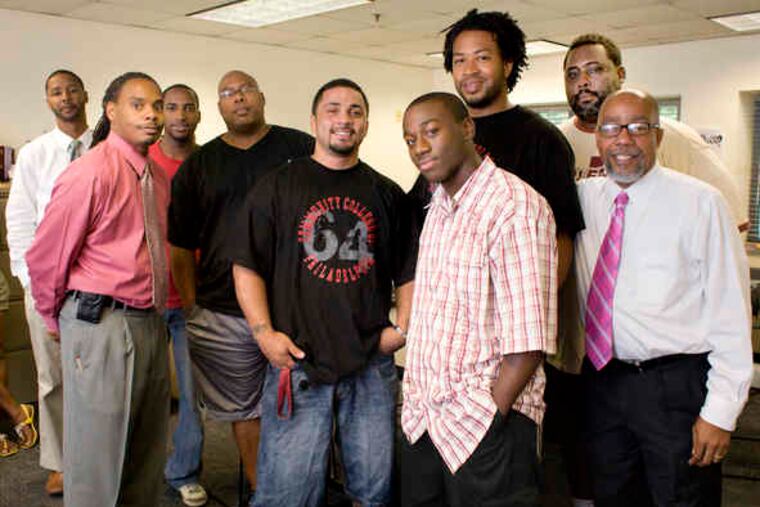Backing the black males
Wayne Williams straightens his tie and turns to the group of young men in the Community College of Philadelphia's student union.

Wayne Williams straightens his tie and turns to the group of young men in the Community College of Philadelphia's student union.
"What is academic swag? Is it necessary?" he asks. Translation - is it important to wear a suit and tie to class?
Clad in T-shirts, Nikes, and basketball shorts, this crowd doesn't appear particularly suave.
But the question gets them thinking. A hand goes up.
"When you dress the part, you're standing apart," the student says. "It's a good way to stand out."
Williams, the chair of the business department, nods.
In a nutshell, that's the goal for these students: standing out among the statistics.
Plagued by high dropout rates among black males and frustrated that many weren't taking advantage of the resources the school provided, the college on Spring Garden Street applied for a U.S. Department of Education grant last year and received $600,000 to reach out to those minority students.
The result? The year-old Center for Male Engagement, where more than 2,800 students have used services since its inception.
The center wants to foster a supportive community: With one-on-one, in-house mentoring programs, academic support coaches, life-skills workshops and financial assistance, it is designed to catch the kids who slip through the cracks and bolster the ones who are already primed to succeed.
While the center is open to any male on campus, grant-funded activities such as cultural excursions and mentoring services are reserved for the "cohort" - 300 students selected through an application process.
This summer, the center hosted an enrichment program and provided scholarships for 60 incoming freshmen (52 completed the program). This fall, the cohort will comprise 150 of the 160 who initially applied for summer enrichment, and 150 from last year's class.
Director Michael Robinson calls the center a vital service at a school that, in 2007, saw only 34 percent of first-year black male students return for a second year at school. (More than 51 percent of its student population is African American.)
Overall retention at community colleges is even more dire: Robinson said that only 18 percent of black males at community colleges go on to complete their degree.
"We are hemorrhaging males of color," Robinson said. "Why do they drop out? For the same reasons any other student would drop out - unawareness of the financial aid process, not being well prepared at secondary school."
Robinson, once a professor at Swarthmore, Newman, and Eastern Universities and an assistant regional director for the Pennsylvania Higher Education Assistance Agency, learned of the center's grant award through a listserv last year and promptly sent in his resume.
These days, Robinson holds court in a small office in the school's student union. Outside, center students study quietly at a few tables piled with textbooks. A large photo of a black man drinking from a segregated water fountain hangs next to Robinson's desk.
"It just provides a historical perspective in terms of black history as to how far we've come in society," Robinson said. "It cites a portion of history where diversity wasn't a very popular thing."
His office door remains open - students, professors, and administrators swoop in and out every few minutes.
A year after the center's launch, Robinson says he's pleased with the way it has gotten its name out - the first year involved "a lot of marketing," he said, from classroom presentations to advertisements on the college's closed-circuit television station to posters around campus.
"Now we need to push ourselves, create stronger ties with faculty," he said.
Williams has taken that to heart. He regularly gives presentations to center students and when not teaching spends his free time tutoring in the center's office or hosting study sessions for an hour or more.
At his presentation to the incoming freshmen, Williams kept it simple - talking mainly about saving money and staying responsible, using real-world examples to bolster his points.
"How often do you think about money?" he asked.
"All day!" someone called out from the back of the room. The group laughed.
"But no matter how much you got, it's never going to be enough," Williams continued. "If I gave you $20 and you just spent it, what does it matter if I give you $20,000?"
One of the biggest challenges of working with center students is simple communication, Williams said. At a school with an "urban, transient student population," he said, many students barely have time to be in class, let alone participate in programming.
That's why the center aims to reach out to students early with its summer enrichment program.
"It gives us a nice little head start," said William Wilson, 18, of North Philadelphia. He heard about the center from a woman at his church and will major in communications in the fall. "And of course the support and the mentorship is great."
But the program isn't just for struggling students; many, like Wilson and his friend Dontay Mohammad - who graduated from high school this year at just 15 years old - come to the center with fully realized goals in mind.
"I just wanted to get school done with earlier," Mohammad said. He's majoring in computer science and plans to run his own software gaming company someday.
Back in the student union, Williams had moved on to a discussion about the importance of setting goals.
"Kindergarten through 12th grade - that's free," he said. "So who goes to college?"
Another hand went up.
"People who want it," someone said. Around the room, heads nodded.